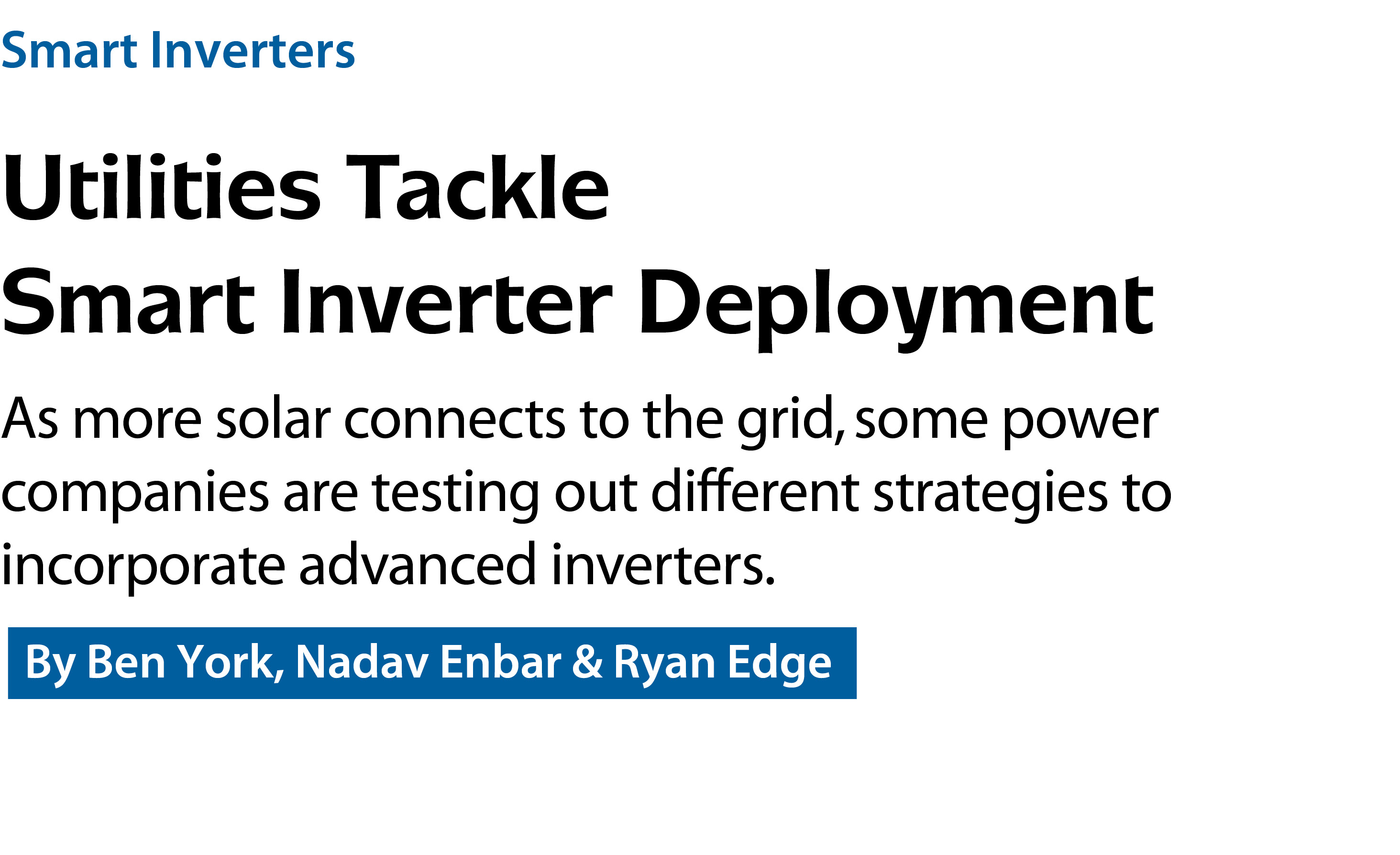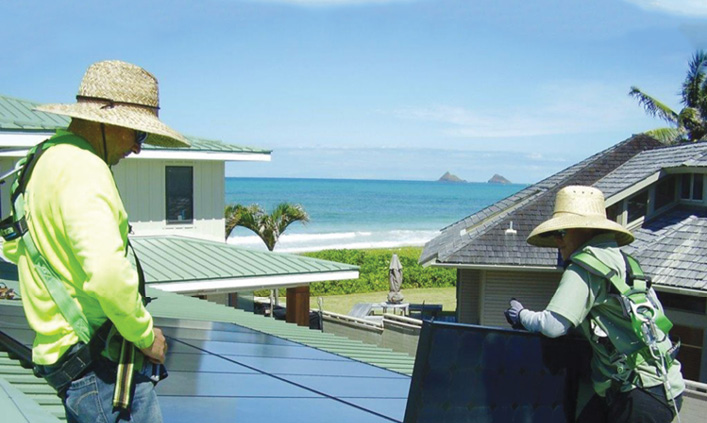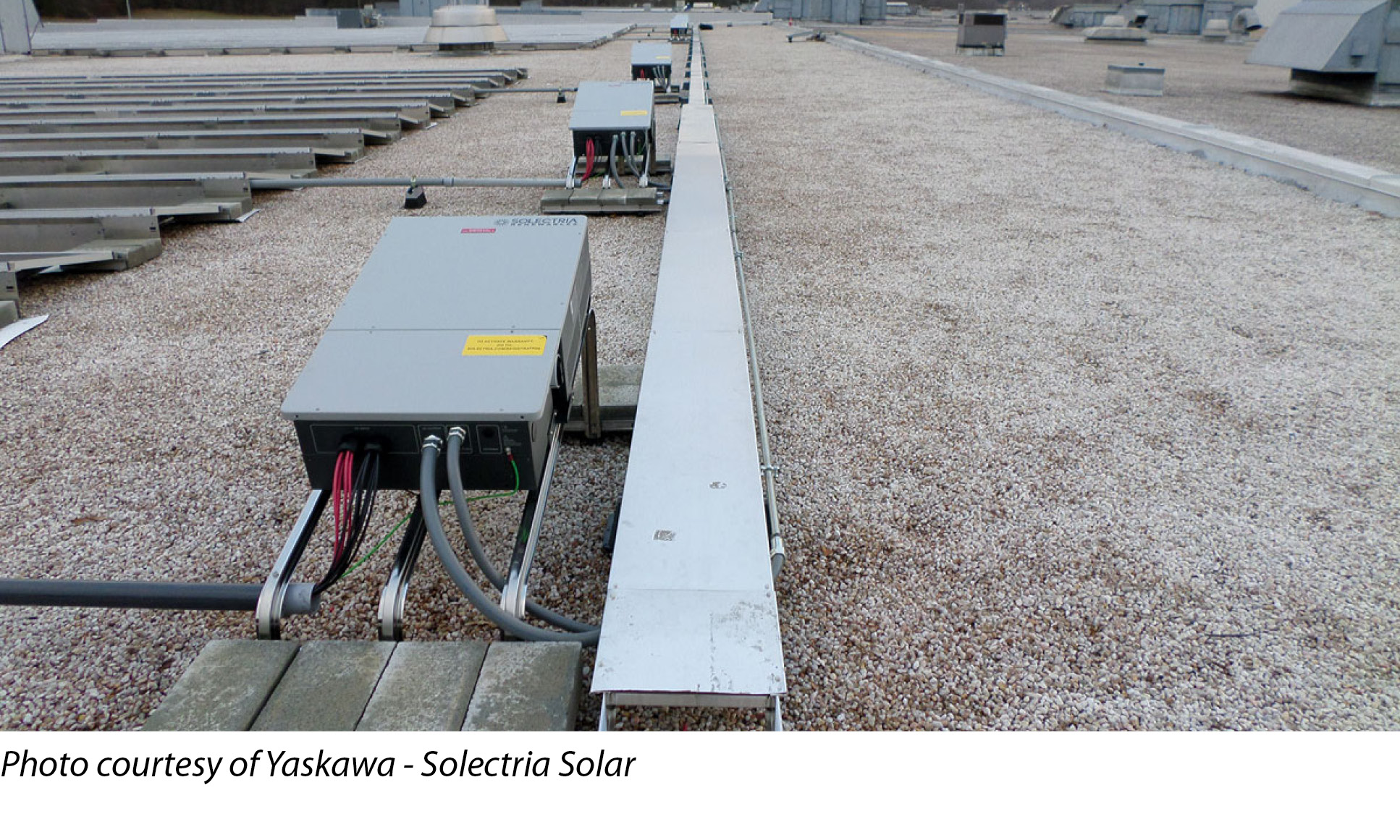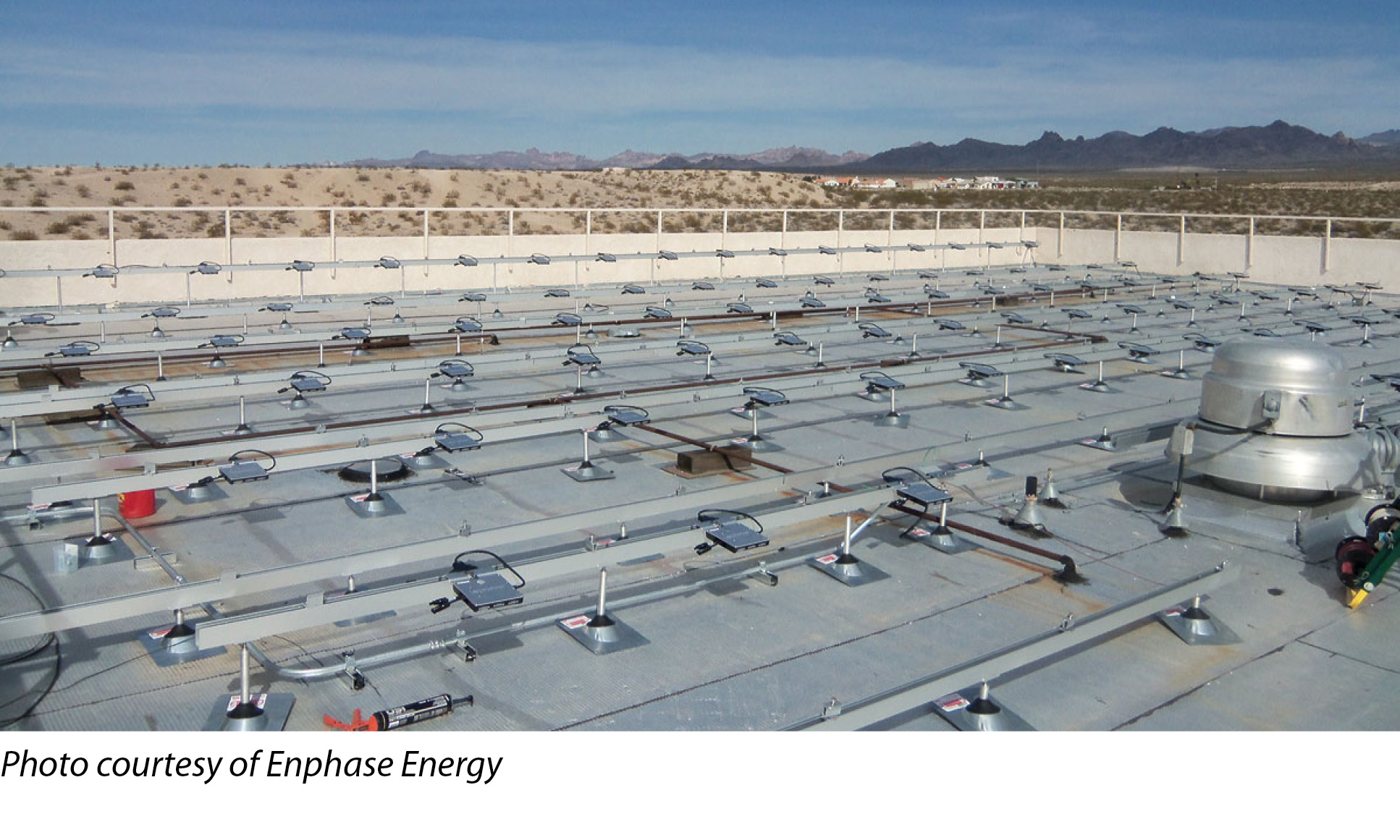

301 Moved Permanently
The widespread deployment of solar photovoltaics in the U.S. has spurred interest in new inverter technology with enhanced grid-supportive functionality. These advanced inverters, also known as “smart” inverters, are primed for widespread commercial rollout over the next five to 10 years.
For electric utilities, inverter technology promises reliability and efficiency benefits needed to manage growing grid penetrations of PV. However, although the technical capabilities of smart inverters are reasonably well understood, practical methods for configuring and deploying the devices are not.
Inverters with grid-support functionality offer utilities new options to operate existing distribution grids through the direct use of distributed PV and, where applicable, energy storage. Because inverters are a core component of every interconnected PV system, these additional capabilities enhance existing assets and enable an improved grid “handshake.”
Enhanced capabilities, which include reactive power compensation, voltage/frequency ride-through and real-time data connectivity, could potentially offer utilities a least-cost tool for mitigating many grid management challenges. In some cases, advanced inverters could help defer or avoid certain distribution, transmission and electric-supply upgrades.
Despite these opportunities, unresolved issues related to the devices’ implementation and use have limited deployment. Ongoing revision of voluntary standards, grid codes, interconnection procedures and communications protocols are affecting utility rollout approaches. Furthermore, customer privacy concerns and regulatory approval of utility inverter ownership are also influencing rollout tactics.
In the pursuit of effective and equitable smart inverter deployment strategies, some U.S. utilities - including Salt River Project, Arizona Public Service, the Hawaiian Electric Companies, and Pacific Gas & Electric (PG&E) - are tackling these complex issues.
Lessons from Germany
Germany, a global leader in PV deployment, has encountered grid-management challenges within areas of high PV penetrations that are instructive to grid operators around the world. Among the issues was the “50.2 Hertz (Hz) problem,” which resulted from rapid deployment of PV systems and deficient requirements for inverter grid support.
Due to a number of factors, including a lucrative feed-in tariff, PV capacity in Germany quickly expanded from negligible levels in 2000 to nearly 18 GW at the end of 2010. Many of the installations were connected to the low-voltage (LV) distribution network. Not anticipating the large-scale deployment, regulators and utilities failed to implement interconnection rules and behaviors suitable for such PV growth, and by 2011, experts began to voice grid-reliability concerns.
PV inverters connected to the LV distribution network had been programmed to immediately disconnect when the system frequency exceeded 50.2 Hz (0.2 Hz above nominal). This contingency appeared innocuous with limited PV interconnections, but with growing deployment, the risk of a single contingency cascading into a larger contingency - or frequency oscillation - at the bulk system level substantially increased.

In response, German authorities instituted two reforms for systems connected at the LV distribution network:
1. Existing PV systems (larger than 10 kW) were required to be retrofitted with a function known as watt-frequency curtailment that gradually inhibits PV output as the system frequency exceeds 50.2 Hz.
2. New PV systems of all sizes became subject to an enhanced grid code (VDE-AR N-4105) that requires not only watt-frequency curtailment, but also under-frequency ride-through and reactive power support.
To improve the ratio of grid benefits to costs, only PV systems larger than 10 kW - which comprised 86% of Germany’s total solar capacity at the time - were targeted for the retrofit. Adding the watt-frequency curtailment function proved to be a simple software change, but it required that a technician install and verify the firmware update on-site.
Although the retrofit was limited to larger systems (roughly 440,000 systems totaling 12.3 GW), the costs have been significant. Estimates range from EUR 100 million to over EUR 300 million, with the retrofit far from completed as of the end of 2015. The high cost and long project duration have been attributed to the large number of installed systems requiring retrofit, as well as the logistics of coordinating numerous parties (e.g., installers, network operators and hardware vendors) in the process.
For systems installed after 2012, an updated grid code has been instituted that defines the interaction of the PV inverter with the distribution network. Under this new arrangement, inverters larger than 3.68 kW are required to provide reactive power, while inverters of all sizes must remain grid connected with a grid frequency above 47.5 Hz.
Additionally, systems larger than 100 kW must be capable of reducing their active power output at the request of the grid operator. Ride-through of high- and low-voltage events, as well as more complex (i.e., voltage-dependent) methods of reactive power control, will not be addressed until further study can confirm the associated benefits and/or risks.
Despite advanced inverter functionality requirements, it remains unclear how reactive power support can be used in practice. Due to existing feeder concentrations, distribution operators in Germany continue to upgrade feeders - often by reconductoring or by increasing transformer capacity - to accommodate additional PV systems.
The number of feeders requiring increased cable or transformer capacity continues to increase. Germany’s experience with smart inverters may help inform strategies governing the technology’s diffusion in other countries. However, it is difficult to directly relate the costs and benefits of the country’s smart inverter rollout to the U.S.
For example, Germany’s distribution system is more densely constructed than most systems in the U.S. (e.g., circuits tend to be shorter), and thus, the concentration of PV per feeder tends to be much greater. As a result, the potential benefits gained from smart inverters in Germany, particularly from reactive power support, have not been fully realized.
In some cases, feeders were already near their thermal capacity limits and therefore required an upgrade regardless. Still, the country’s experiences have raised general awareness in the U.S. about grid-reliability issues posed by rising penetrations of PV, the effect of grid codes and the challenges of retrofitting inverters with advanced functionality. Documented results have helped inform policy discussions, as well as technology enhancements.
U.S. utility approaches
In the U.S., a handful of utilities have started to pursue smart inverter deployments. These utilities are employing a range of rollout approaches governed by differing circumstances and objectives.
In at least one instance, as was the case in Germany, the deployment strategy is a reaction to existing grid operational issues driven by high PV penetration. In others, plans appear to be more proactively rooted in pilot-based learning and incremental rollout. Furthermore, some strategies are largely based upon their adherence to grid codes, while others have a greater degree of flexibility. Two examples of power companies taking on smart inverter deployment include the Hawaiian Electric Companies and PG&E.
Hawaiian Electric Companies
The Hawaiian Electric Companies lead the nation in per-capita PV installations. Like Germany, the majority of the PV systems in Hawaii have been installed according to (since-revised) interconnection rules that restrict inverter grid support technologies. What makes Hawaii unique, however, is the small, isolated nature of the islands’ grids.
Within this context, inverter response to voltage and frequency events is significantly more important because each grid network must be self-sufficient; it cannot rely on neighboring electricity systems for support. Consequently, both centralized and distributed PV have become essential to the infrastructure of each of the Hawaiian Islands.
To improve inverter response to transient events, Hawaiian Electric initially worked with equipment vendors and installers in 2011 to widen the underfrequency trip limits of connected inverters from the standard 59.7 Hz to a more generous 57 Hz. Another significant step would, however, prove necessary to transform a “must trip by” requirement into a “must ride-through unless” requirement that prevents inverter-based generation from tripping during a transient event and potentially leaving the grid vulnerable to cascading events.
In early 2014, initial definitions for ride-through for distributed PV inverters were under development in California (Rule 21), and compliant equipment was still at least a year away. Around this time, Hawaiian Electric, working alongside industry and the Hawaii Public Utilities Commission, developed additional requirements for both voltage and frequency ride-through suitable for their island systems.
The result was a requirement that new PV systems installed after February 2015 have embedded ride-through functionality in order to better support bulk system reliability. A commission ruling in October 2015 has subsequently expanded the role of smart inverters to include voltage support and remote configurability, in addition to bulk system support functions.
Because Hawaii’s distribution feeders are fairly compact, making PV concentrations reasonably dense (similar to Germany), voltage management issues have been determined to be less pressing than overall system reliability needs.
Going forward, inverter ride-through requirements will be stipulated as part of the interconnection agreement for new systems. Beyond the development of requirements for new systems, Hawaiian Electric has also recommended retrofitting existing PV systems with ride-through settings. Given the quantity of small, residential PV systems, especially on the island of Oahu, retrofits requiring a site visit from a technician could have been both cumbersome and costly. But the inverter manufacturer Enphase was able to conduct an over-the-air software update that added the necessary functionality to the majority of its installed inverter base. In a single day, 800,000 individual micro-inverter units on the island that controlled 140 MW (roughly half of Oahu’s PV capacity) were reprogrammed with the new features.

Pacific Gas & Electric
San Francisco-based PG&E is a leading “solar utility” in the U.S. Serving over 5 million customer accounts in central and northern California, the utility has among the highest solar penetration rates in the nation.
Unlike the Hawaiian Electric Companies’ inverter implementation, PG&E’s strategy is essentially rooted in compliance with new state-level requirements stipulated in recent revisions to the California Public Utilities Commission’s (CPUC) Rule 21, the tariff that ascribes the technical interconnection, operation and metering requirements for connecting distributed generators to California’s electric system. As such, PG&E and the state’s other investor-owned utilities are following the administrative rules to roll out smart inverters in their respective service areas.
Rule 21 has been amended to support advanced inverter functionality as a means to expanding solar interconnections. The revisions are the product of a multiyear effort undertaken by the Smart Inverter Working Group (SIWG), formed by the CPUC and the California Energy Commission, to identify and overcome the technical challenges of incorporating advanced inverters into grid operations. Comprising more than 50 organizations, including PG&E, other utilities, manufacturers and solar developers, the SIWG collaboration has provided an open forum for revising Rule 21.
The Rule 21 amendments will be implemented in three phases. Phase 1, which commenced in early 2016, enables autonomous inverter operations only; however, this is not a requirement until UL 1741 test procedures are approved. Phase 2 will incorporate IEC 6185018 and IEEE 2030.5 (SEP 2.0) communications capabilities and cybersecurity measures. Finally, Phase 3 will implement advanced functionality through robust integration with dynamic controls and inverter dispatchability.
As written in the revision language, new inverter functionality must be implemented for all new solar interconnections within one year of the finalized update to the UL 1741 SA testing procedures, now expected to occur this year. UL 1741 is an equipment safety standard that certifies a specific piece of equipment as safe for a given use, and it applies to inverters, converters, controllers and interconnection equipment for use with distributed energy resources (DER). Each enhanced inverter function affected by Rule 21 requires a new equipment safety test to be administered by UL.
Phase 1 will primarily implement autonomous functionality, including expanded ride-through parameters and power quality support, among other functions. These functions do not require robust communication schemes to facilitate complex interaction with other utility systems, including substations, distribution management systems and advanced metering infrastructure. Current standards require inverters to trip off if grid frequency or voltage deviates from a narrowly defined operating window. The expanded ride-through settings in Rule 21 are intended to keep inverters connected to the grid longer during system disturbances.
PG&E actively monitors the penetration of distributed generation on its feeders. As of November 2015, the total distributed generation penetration on the distribution system was about 10% of peak load; 80% of that is PV, but individual feeders range from 0% to beyond 200% of the feeder’s peak load. At the rate solar has grown on its system, many circuits are expected to reach 100% of peak load by around 2020.
Because each project is reviewed/mitigated prior to interconnection, PG&E does not expect any significant distribution system issues to result from high penetration levels. In addition to ride-through, Rule 21 Phase 1 calls for an adjustable volt/var setting. By default, this function will not be enabled in order to avoid potentially unstable inverter interactions that could cause local voltage to exceed CPUC limits. The utility will have the discretion to activate it after a study of the circuit to ensure that the inverters can be coordinated and used as resources for reactive power. The use of inverters for var support in this way must not come at the expense of real power output.
Utilities in California have the flexibility to implement Rule 21 before the effective deadline, and PG&E may do so on a case-by-case basis as feeder conditions warrant. Despite the vast deployment of PV in PG&E’s service territory to date, the utility has no plans to retrofit inverters on previously installed systems. Revised Rule 21 requirements will be mandated for new interconnections, but existing installations will be grandfathered.
Key findings
With significant growth in PV deployment over the last few years, utilities are paying more attention to the grid-support potential of smart inverters. Now the industry is grappling with the details of when and how to require smart inverters and what settings and functions to demand.
Several utilities already have strategies for unlocking advanced inverter functionality. Given the momentum of solar and the magnitude of the potential integration challenge, other utilities may soon be considering rollout strategies of their own.
Like their German counterparts, much of the Hawaiian Electric Companies’ actions have been borne of necessity. On the mainland, however, a transition to smart inverters seems to lack the same urgency as Hawaii. Stakeholders are more methodically determining if and when the technology will be required.
California’s approach is statewide. Meanwhile, Arizona’s Salt River Project and Arizona Public Service have proactively initiated multiyear research pilots to evaluate a limited deployment of smart inverters. In New York, individual feeder studies have been performed with smart inverters, but it remains to be seen whether statewide requirements through regulatory activities will impact deployment requirements.
That said, at least three common themes emerged among several utilities studied that also apply to the industry at large:
1. Autonomous grid-support functionality can be readily deployed at low cost. The utility implementation strategies studied for this article include autonomous behavior of advanced inverters for frequency and voltage ride-through, ramp rate control, and fixed power factor functions. These low-cost functions hold significant operational benefits for utilities.
Though smart inverters can provide some grid-support functionality at a minimal incremental cost, expensive communications infrastructure is necessary to maximize the grid benefits of many advanced inverter functions. This connectivity adds more deployment cost than the incremental cost for the advanced inverter hardware alone. As a result, autonomous functionality has been a common theme among utility pilot projects to deliver grid benefits while avoiding costly communication investments.
2. Communications-based functionality remains a trade-off between inverter capabilities and implementation cost. Distribution optimization is being considered through the integration of inverter hardware with utility SCADA and other control software, such as distributed energy resource management systems. Major challenges include utility access to needed data and the analytical capability to process the data and update communication settings to alter distributed generation assets. Communications bandwidth will be required to interconnect and manage DER. In recognition of this, PG&E and Rule 21 have delayed the implementation of communications-enabled functionality until Phase 2.
3. Inverter retrofits can be effectively managed. Utilities in the U.S. have avoided costly inverter retrofit efforts. Sufficient time remains, even in areas with the greatest grid penetration, to implement a deployment strategy. Even in Hawaii, where feeder penetrations are highest, Hawaiian Electric has worked with stakeholders to ensure that inverters deployed on its system can support the grid during modeled disturbances. It has, furthermore, successfully overseen a relatively inexpensive remote software update to more than 800,000 micro-inverters as of November 2015. Other U.S. utilities have reported that similar retrofits will not be necessary.

Conclusion
The challenge facing the industry over the next several years and beyond will be to determine how to practically deploy and operate smart inverters. Absent a national grid code in the U.S., however, no single approach is likely to take root.
Instead, divergent deployment strategies will incorporate core elements - universal vs. selective adoption, full advanced inverter functionality vs. more basic power factor capability, adherence to statewide smart inverter policy vs. market-based doctrines - that will be based upon context-specific distribution system attributes, load growth forecasts and cost-benefit calculations.
utility pilot and full-scale rollouts of the technology in the near future. With research, experimentation and “learning by doing,” we expect viable pathways forward to be clarified.
Smart Inverters
Utilities Tackle Smart Inverter Deployment
By Ben York, Nadav Enbar & Ryan Edge
As more solar connects to the grid, some power companies are testing out different strategies to incorporate advanced inverters.
si body si body i si body bi si body b
si depbio
- si bullets
si sh
si subhead
pullquote
si first graph
si sh no rule
si last graph